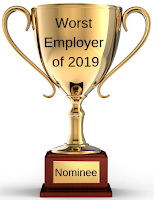Throughout 2018 I tracked the worst behavior America’s employers offered up to their workforces.
I found each of the examples I tracked in actual court filings or in news stories. These are actual employers doing actual awful things to their employees.
How truly awful does one need to be to be named the 2018 Worst Employer of the Year? Consider that the following bad bosses did not make the cut in our online poll:
The Pregnancy Provoker: A supervisor compared an employee’s pregnancy to a tumor, expressed hope that she’d miscarry so that she wouldn’t miss work and told her to keep her legs crossed to delay childbirth so she could keep working.
The Soulless Supervisor: A supervisor fired an employee via text message while she was bedside with her son on life support.
The HR Pimp: A human resources chief hired women as possible sexual partners to men working for his government agency.
The Camera Creep: An employer ignored complaints that its general counsel had installed a hidden camera in the women’s locker room and had videos of nude and partially clothed female employees on his computer.
The Sadistic Sergeant: A police sergeant held a gun to an applicant’s head and threatened to shoot him if he made a mistake on his job application.
The Hedonistic Harasser: A company ignored complaints about genital grabbing and pantomimed rape, and further ignored complaints about threats of violence after the victim complained.
And if you think those were bad, here are the four worst, according to our online readers who voted on their favorite (or perhaps in this case, least favorite) bad bosses of 2018.
The Sexist, Racist, Xenophobic, Oh My!: A plant manager used racial slurs toward his employees, such as calling foreign-born employees “terrorists” and telling the company’s only African-American employee that her husband should work in a cotton field with a rope around his neck. The same plant manager also complained that he was “sick” of immigrants stealing jobs from Americans and not speaking English, forbade employees from speaking foreign languages and urged immigrant employees to leave America. Female employees did not fare much better, with the plant manager calling them “bitches,” and told one female employee that she was too “fat and disgusting” to have sex with her husband. When employees complained to the company’s owner, he not only did nothing to stop the harassment, he also became an active participant.
The Supervisor Supremacist: A supervisor made numerous racist remarks to his lone African-American employee, including “white power,” “if you’re not white, you’re not right,” telling him to leave because the other employees were having a Klan meeting, and using the N-word. He also started his morning meetings by saying “white power” and giving the Nazi salute. The supervisor placed a jockey statue on the employee’s desk, affixed a whip in the jockey’s hand, tied the whip around the horse’s neck in a noose, and labeled the statue with the name of the African-American employee. Finally, someone painted a troll doll black and hanged it in the plant labeled with the name of the African-American employee.
The Tasering Torturer: A car salesman alleged that the dealership’s owner engaged in a continuous and unrelenting campaign of verbal and physical abuse and harassment, including: repeatedly demeaning him based on his large size with names such as “Tiny,” “Fat Ass,” and “handicapped”; pointing the red laser-sight of a handgun at him; placing the handgun to his chest while telling him not to make any sudden moves; holding knives or other sharp objects to his throat while demanding that he not make any sudden movements; telling him he could “slit [his] throat and sleep just fine at night”; striking his surgically repaired leg; lighting fires near him; and finally, repeatedly shocking him with a taser.
My vote, however, for the Worst Employer of 2018 goes to the owner of a Cleveland area convenience store who (allegedly) hired two men to rough up a handyman who was not performing up to standards. They went too far, however, which resulted in the handyman’s death. Criminal charges are pending. If you (allegedly) cause the death of an employee by (allegedly) hiring two men to rough him up as a workplace motivational tool, you’ve earned my vote for the Worst Employer of 2018.
While we can all cringe at how truly awful these employers are, there are basic lessons about harassment, sexism, racism, bullying and abuse undercutting each of these examples. So, employers, here is your goal for the new year, and it’s relatively simple to achieve: Do not end up on this list in 2019!



 A federal court jury in Miami has awarded a hotel dishwasher $21.5 million after concluding that her employer failed to honor her religious beliefs by repeatedly scheduling her on Sundays, and then firing her.The hotel argued that it had no idea that she was a missionary or had requested Sunday off. Her lawyer, however, disagreed. “There were letters in [her personnel] file and her pastor went down there.”
A federal court jury in Miami has awarded a hotel dishwasher $21.5 million after concluding that her employer failed to honor her religious beliefs by repeatedly scheduling her on Sundays, and then firing her.The hotel argued that it had no idea that she was a missionary or had requested Sunday off. Her lawyer, however, disagreed. “There were letters in [her personnel] file and her pastor went down there.” The Equal Pay Act requires that an employer pay its male and female employees equal pay for equal work. The jobs need not be identical, but they must be substantially equal. Substantial equality is measured by job content, not job titles.
The Equal Pay Act requires that an employer pay its male and female employees equal pay for equal work. The jobs need not be identical, but they must be substantially equal. Substantial equality is measured by job content, not job titles. How did the oboist end up earning more? According to the lawsuit, the orchestra lured him away from the Metropolitan Opera Orchestra with the promise of higher pay. Rowe claims that she should be paid equally for similar work, regardless of the circumstances of his recruiting.
How did the oboist end up earning more? According to the lawsuit, the orchestra lured him away from the Metropolitan Opera Orchestra with the promise of higher pay. Rowe claims that she should be paid equally for similar work, regardless of the circumstances of his recruiting.



